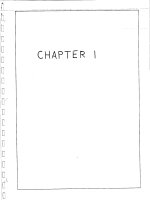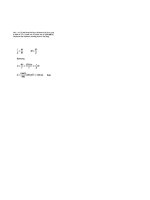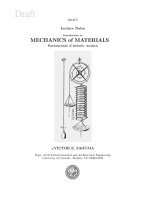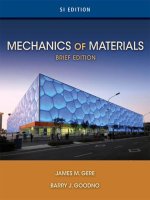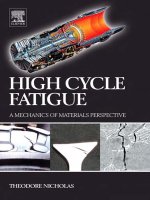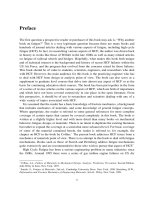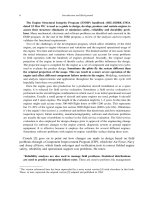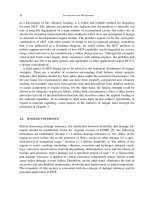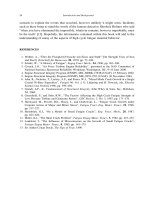Mechanics of Materials
Bạn đang xem bản rút gọn của tài liệu. Xem và tải ngay bản đầy đủ của tài liệu tại đây (44.8 MB, 622 trang )
PRINCIPAL UNITS USED IN MECHANICS
International System (SI)
Quantity
Unit Symbol Formula
Acceleration (angular) radian per second squared rad/s
2
Acceleration (linear) meter per second squared m/s
2
Area square meter m
2
Density (mass) kilogram per cubic meter kg/m
3
(Specific mass)
Density (weight) newton per cubic meter N/m
3
(Specific weight)
Energy; work joule J Nиm
Force newton N kgиm/s
2
Force per unit length newton per meter N/m
(Intensity of force)
Frequency hertz Hz s
Ϫ1
Length meter m (base unit)
Mass kilogram kg (base unit)
Moment of a force; torque newton meter Nиm
Moment of inertia (area) meter to fourth power m
4
Moment of inertia (mass) kilogram meter squared kgиm
2
Power watt W J/s
(Nиm/s)
Pressure pascal Pa N/m
2
Section modulus meter to third power m
3
Stress pascal Pa N/m
2
Time second s (base unit)
Velocity (angular) radian per second rad/s
Velocity (linear) meter per second m/s
Volume (liquids) liter L 10
Ϫ3
m
3
Volume (solids) cubic meter m
3
SI PREFIXES
Prefix Symbol Multiplication factor
tera T 10
12
ϭ 1 000 000 000 000.
giga G 10
9
ϭ 1 000 000 000.
mega M 10
6
ϭ 1 000 000.
kilo k 10
3
ϭ 1 000.
hecto h 10
2
ϭ 100.
deka da 10
1
ϭ 10.
deci d 10
Ϫ1
ϭ 0.1
centi c 10
Ϫ2
ϭ 0.01
milli m 10
Ϫ3
ϭ 0.001
micro
10
Ϫ6
ϭ 0.000 001
nano n 10
Ϫ9
ϭ 0.000 000 001
pico p 10
Ϫ12
ϭ 0.000 000 000 001
Note: The use of the prefixes hecto, deka, deci, and centi is not recommended in SI.
SELECTED PHYSICAL PROPERTIES
Property SI
Water (fresh)
weight density 9.81 kN/m
3
mass density 1000 kg/m
3
Sea water
weight density 10.0 kN/m
3
mass density 1020 kg/m
3
Aluminum (structural alloys)
weight density 28 kN/m
3
mass density 2800 kg/m
3
Steel
weight density 77.0 kN/m
3
mass density 7850 kg/m
3
Reinforced concrete
weight density 24 kN/m
3
mass density 2400 kg/m
3
Atmospheric pressure (sea level)
Recommended value 101 kPa
Standard international value 101.325 kPa
Acceleration of gravity
(sea level, approx. 45° latitude)
Recommended value 9.81 m/s
2
Standard international value 9.80665 m/s
2
This is an electronic version of the print textbook. Due to electronic rights restrictions,
some third party content may be suppressed. Editorial review has deemed that any suppressed
content does not materially affect the overall learning experience. The publisher reserves the right
to remove content from this title at any time if subsequent rights restrictions require it. For
valuable information on pricing, previous editions, changes to current editions, and alternate
formats, please visit www.cengage.com/highered to search by ISBN#, author, title, or keyword for
materials in your areas of interest.
Mechanics of
Materials
BRIEF EDITION, SI
This page intentionally left blank
Mechanics of Materials
BRIEF EDITION, SI
James M. Gere
Late Professor Emeritus, Stanford University
Barry J. Goodno
Georgia Institute of Technology
Australia • Brazil • Japan • Korea • Mexico • Singapore • Spain • United Kingdom • United States
Mechanics of Materials, Brief Edition, SI
James M. Gere and Barry J. Goodno
Publisher, Global Engineering:
Christopher M. Shortt
Acquisitions Editor: Randall Adams
Senior Developmental Editor: Hilda Gowans
Editorial Assistant: Tanya Altieri
Team Assistant: Carly Rizzo
Marketing Manager: Lauren Betsos
Media Editor: Chris Valentine
Content Project Manager: Jennifer Ziegler
Production Service: RPK Editorial Services
Copyeditor: Shelly Gerger-Knechtl
Proofreader: Martha McMaster
Indexer: Shelly Gerger-Knechtl
Compositor: Integra Software Solutions
Senior Art Director: Michelle Kunkler
Internal Designer: Peter Papayanakis
Cover Designer: Andrew Adams/4065042
Canada Inc.
Cover Images: © iPhotos/Shutterstock
Text and Image Permissions Researcher:
Kristiina Paul
First Print Buyer: Arethea L. Thomas
© 2012 Cengage Learning
ALL RIGHTS RESERVED. No part of this work covered by the
copyright herein may be reproduced, transmitted, stored or
used in any form or by any means graphic, electronic, or
mechanical, including but not limited to photocopying,
recording, scanning, digitizing, taping, Web distribution,
information networks, or information storage and retrieval
systems, except as permitted under Section
107 or 108 of the
1976 United States Copyright Act, without the prior written
permission of the publisherexcept as may be permitted by the
license terms below.
For product information and technology assistance,
contact us at Cengage Learning Academic
Resource Center, 1-800-423-0563.
For permission to use material from this text or product,
submit all requests online at www.cengage.com/permissions.
Further permissions questions can be emailed to
Library of Congress Control Number: 2011924094
ISBN-13: 978-1-111-13603-1
ISBN-10: 1-111-13603-3
Cengage Learning
200 First Stamford Place, Suite 400
Stamford, CT 06902
USA
Cengage Learning is a leading provider of customized learning
solutions with office locations around the globe, including
Singapore, the United Kingdom, Australia, Mexico, Brazil, and
Japan. Locate your local office at:
international.cengage.com/region.
Cengage Learning products are represented in Canada by
Nelson Education Ltd.
For your course and learning solutions, visit
www.cengage.com/engineering.
Purchase any of our products at your local college store or at
our preferred online store www.cengagebrain.com.
Printed in Canada
1 2 3 4 5 6 7 13 12 11
Contents
James Monroe Gere ix
Preface—Brief Edition, SI x
Symbols xvi
Greek Alphabet xix
1 Tension, Compression, and Shear 3
1.1 Introduction to Mechanics of Materials 5
1.2 Normal Stress and Strain 6
1.3 Mechanical Properties of Materials 15
1.4 Elasticity, Plasticity, and Creep 24
1.5 Linear Elasticity, Hooke’s Law, and Poisson’s Ratio 27
1.6 Shear Stress and Strain 32
1.7 Allowable Stresses and Allowable Loads 43
1.8 Design for Axial Loads and Direct Shear 49
Chapter Summary & Review 55
Problems 57
2 Axially Loaded Members 89
2.1 Introduction 90
2.2 Changes in Lengths of Axially Loaded Members 90
2.3 Changes in Lengths Under Nonuniform Conditions 99
2.4 Statically Indeterminate Structures 106
2.5 Thermal Effects, Misfits, and Prestrains 115
2.6 Stresses on Inclined Sections 127
Chapter Summary & Review 139
Problems 141
3 Torsion 169
3.1 Introduction 170
3.2 Torsional Deformations of a Circular Bar 171
3.3 Circular Bars of Linearly Elastic Materials 174
v
3.4 Nonuniform Torsion 186
3.5 Stresses and Strains in Pure Shear 193
3.6 Relationship Between Moduli of Elasticity E and G 200
3.7 Transmission of Power by Circular Shafts 202
3.8 Statically Indeterminate Torsional Members 207
Chapter Summary & Review 211
Problems 213
4 Shear Forces and Bending Moments 233
4.1 Introduction 234
4.2 Types of Beams, Loads, and Reactions 234
4.3 Shear Forces and Bending Moments 239
4.4 Relationships Between Loads, Shear Forces,
and Bending Moments 248
4.5 Shear-Force and Bending-Moment Diagrams 253
Chapter Summary & Review 264
Problems 266
5 Stresses in Beams 279
5.1 Introduction 281
5.2 Pure Bending and Nonuniform Bending 281
5.3 Curvature of a Beam 282
5.4 Longitudinal Strains in Beams 284
5.5 Normal Stresses in Beams (Linearly Elastic Materials) 289
5.6 Design of Beams for Bending Stresses 302
5.7 Shear Stresses in Beams of Rectangular Cross Section 311
5.8 Shear Stresses in Beams of Circular Cross Section 321
5.9 Shear Stresses in the Webs of Beams with Flanges 324
5.10 Composite Beams 332
Chapter Summary & Review 347
Problems 350
6 Analysis of Stress and Strain 377
6.1 Introduction 379
6.2 Plane Stress 380
6.3 Principal Stresses and Maximum Shear Stresses 388
6.4 Mohr’s Circle for Plane Stress 398
6.5 Hooke’s Law for Plane Stress 415
6.6 Triaxial Stress 418
Chapter Summary & Review 422
Problems 425
vi CONTENTS
7 Applications of Plane Stress (Pressure Vessels and Combined Loadings) 439
7.1 Introduction 440
7.2 Spherical Pressure Vessels 440
7.3 Cylindrical Pressure Vessels 446
7.4 Combined Loadings 454
Chapter Summary & Review 470
Problems 471
8 Deflections of Beams 485
8.1 Introduction 486
8.2 Differential Equations of the
Deflection Curve 486
8.3 Deflections by Integration of the
Bending-Moment Equation 492
8.4 Deflections by Integration of the Shear-Force
and Load Equations 503
8.5 Method of Superposition 509
Chapter Summary & Review 518
Problems 519
9 Columns 531
9.1 Introduction 532
9.2 Buckling and Stability 532
9.3 Columns with Pinned Ends 536
9.4 Columns with Other Support Conditions 547
Chapter Summary & Review 558
Problems 559
10 Review of Centroids and Moments of Inertia (Available on book website)
10.1 Introduction
10.2 Centroids of Plane Areas
10.3 Centroids of Composite Areas
10.4 Moments of Inertia of Plane Areas
10.5 Parallel-Axis Theorem for Moments of Inertia
10.6 Polar Moments of Inertia
10.7 Products of Inertia
10.8 Rotation of Axes
10.9 Principal Axes and Principal Moments
of Inertia
Problems
CONTENTS vii
References and Historical Notes R1
Appendix A Systems of Units and Conversion Factors A1
Appendix B Problem Solving B1
Appendix C Mathematical Formulas C1
Appendix D Properties of Plane Areas D1
Appendix E Properties of Structural-Steel Shapes E1
Appendix F Properties of Solid Timber F1
Appendix G Deflections and Slopes of Beams G1
Appendix H Properties of Materials H1
Answers to Problems 571
Index 585
viii CONTENTS
James Monroe Gere
1925–2008
James Monroe Gere, Professor Emeritus of Civil Engineering at Stanford University, died in
Portola Valley, CA, on January 30, 2008. Jim Gere was born on June 14, 1925, in Syracuse,
NY. He joined the U.S. Army Air Corps at age 17 in 1942, serving in England, France and
Germany. After the war, he earned undergraduate and master’s degrees in Civil Engineering
from the Rensselaer Polytechnic Institute in 1949 and 1951, respectively. He worked as an
instructor and later as a Research Associate for Rensselaer between 1949 and 1952. He was
awarded one of the first NSF Fellowships, and chose to study at Stanford. He received his
Ph.D. in 1954 and was offered a faculty position in Civil Engineering, beginning a 34-year
career of engaging his students in challenging topics in mechanics, and structural and earth-
quake engineering. He served as Department Chair and Associate Dean of Engineering and in
1974 co-founded the John A. Blume Earthquake Engineering Center at Stanford. In 1980, Jim
Gere also became the founding head of the Stanford Committee on Earthquake Preparedness,
which urged campus members to brace and strengthen office equipment, furniture, and other
contents items that could pose a life safety hazard in the event of an earthquake. That same year, he was invited as one of
the first foreigners to study the earthquake-devastated city of Tangshan, China. Jim retired from Stanford in 1988 but con-
tinued to be a most valuable member of the Stanford community as he gave freely of his time to advise students and to
guide them on various field trips to the California earthquake country.
Jim Gere was known for his outgoing manner, his cheerful personality and wonderful
smile, his athleticism, and his skill as an educator in Civil Engineering. He authored nine text-
books on various engineering subjects starting in 1972 with Mechanics of Materials, a text that
was inspired by his teacher and mentor Stephan P. Timoshenko. His other well-known text-
books, used in engineering courses around the world, include: Theory of Elastic Stability,
co-authored with S. Timoshenko; Matrix Analysis of Framed Structures and Matrix Algebra
for Engineers, both co-authored with W. Weaver; Moment Distribution; Earthquake Tables:
Structural and Construction Design Manual, co-authored with H. Krawinkler; and Terra Non
Firma: Understanding and Preparing for Earthquakes, co-authored with H. Shah.
Respected and admired by students, faculty, and staff at Stanford University, Professor
Gere always felt that the opportunity to work with and be of service to young people both
inside and outside the classroom was one of his great joys. He hiked frequently and regu-
larly visited Yosemite and the Grand Canyon national parks. He made over 20 ascents of
Half Dome in Yosemite as well as “John Muir hikes” of up to 50 miles in a day. In 1986 he
hiked to the base camp of Mount Everest, saving the life of a companion on the trip. James
was an active runner and completed the Boston Marathon at age 48, in a time of 3:13.
James Gere will be long remembered by all who knew him as a considerate and loving
man whose upbeat good humor made aspects of daily life or work easier to bear. His last proj-
ect (in progress and now being continued by his daughter Susan of Palo Alto) was a book
based on the written memoirs of his great-grandfather, a Colonel (122d NY) in the Civil War.
Jim Gere in the Timoshenko
Library at Stanford holding a
copy of the 2nd edition of this
text (photo courtesy of Richard
Weingardt Consultants, Inc.)
ix
Preface—Brief Edition, SI
Mechanics of materials is a basic engineering subject that, along with
statics, must be understood by anyone concerned with the strength and
physical performance of structures, whether those structures are man-
made or natural. At the college level, mechanics of materials is usually
taught during the sophomore and junior years. The subject is required for
most students majoring in mechanical, structural, civil, biomedical, petro-
leum, aeronautical, and aerospace engineering. Furthermore, many
students from such diverse fields as materials science, industrial engineer-
ing, architecture, and agricultural engineering also find it useful to study
this subject.
About the Brief Edition
In many university engineering programs today, both statics and mechan-
ics of materials are now taught in large sections comprised of students
from the variety of engineering disciplines listed above. Instructors for
the various parallel sections must cover the same material, and all of the
major topics must be presented so that students are well prepared for
the more advanced and follow-on courses required by their specific
degree programs. There is little time for advanced or specialty topics
because fundamental concepts such as stress and strain, deformations and
displacements, flexure and torsion, shear and stability must be covered
before the term ends. As a result, there has been increased interest in a
more streamlined, or brief, text on mechanics of materials that is focused
on the essential topics that can and must be covered in the first under-
graduate course. This text has been designed to meet this need.
The main topics covered in this book are the analysis and design of
structural members subjected to tension, compression, torsion, and bending,
including the fundamental concepts mentioned above. Other important top-
ics are the transformations of stress and strain, combined loadings and
combined stress, deflections of beams, and stability of columns. Unfortu-
nately, it is no longer possible in most programs to cover a number of
specialized subtopics which were removed to produce this “brief” edition.
This streamlined text is based on the review comments of many instructors
who asked for a text specifically tailored to the needs of their semester
length course, with advanced material removed. The resulting brief text,
x
based upon and derived from the full seventh edition of this text book, cov-
ers the essential topics in the full text with the same level of detail and rigor.
Some of the specialized topics no longer covered here include the
following: stress concentrations, dynamic and impact loadings, nonpris-
matic members, shear centers, bending of unsymmetric beams, maximum
stresses in beams, energy based approaches for computing deflections of
beams, and statically indeterminate beams. A discussion of beams of two
materials, or composite beams, was retained but moved to the end of the
chapter on stresses in beams. Review material on centroids and moments
of inertia was also removed from the text but was placed online so is still
available to the student. Finally, Appendices A-H, as well as References
and Historical Notes, were moved online to shorten the text while retain-
ing a comprehensive discussion of major topics.
As an aid to the student reader, each chapter begins with a Chapter
Overview which highlights the major topics to be covered in that chapter,
and closes with a Chapter Summary & Review in which the key points as
well as major mathematical formulas presented in the chapter are listed
for quick review (in preparation for examinations on the material). Each
chapter also opens with a photograph of a component or structure which
illustrates the key concepts to be discussed in that chapter.
Considerable effort has been spent in checking and proofreading the
text so as to eliminate errors, but if you happen to find one, no matter
how trivial, please notify me by e-mail (). We
will correct any errors in the next printing of the book.
Examples
Examples are presented throughout the book to illustrate the theoretical
concepts and show how those concepts may be used in practical situations.
In some cases, photographs have been added showing actual engineering
structures or components to reinforce the tie between theory and applica-
tion. Many instructors discuss lessons learned from engineering failures to
motivate student interest in the subject matter and to illustrate basic con-
cepts. In both lecture and text examples, it is appropriate to begin with
simplified analytical models of the structure or component and the associ-
ated free-body diagram(s) to aid the student in understanding and applying
the relevant theory in engineering analysis of the system. The text exam-
ples vary in length from one to four pages, depending upon the complexity
of the material to be illustrated. When the emphasis is on concepts, the
examples are worked out in symbolic terms so as to better illustrate the
ideas, and when the emphasis is on problem-solving, the examples are
numerical in character. In selected examples throughout the text, graphical
display of results (e.g., stresses in beams) has been added to enhance the
student’s understanding of the problem results.
Problems
In all mechanics courses, solving problems is an important part of the
learning process. This textbook offers more than 700 problems for
PREFACE xi
homework assignments and classroom discussions. The problems are
placed at the end of each chapter so that they are easy to find and don’t
break up the presentation of the main subject matter. Also, problems are
generally arranged in order of increasing difficulty thus alerting students
to the time necessary for solution. Answers to all problems are listed
near the back of the book. An Instructor Solution Manual (ISM) is avail-
able to registered instructors at the publisher’s web site.
In addition to the end of chapter problems, more than 100 review
problems have been added (on average, 10 or more per chapter) which
combine a number of important concepts presented in the chapter. These
problems are intended to test the student’s knowledge and understanding
of the overall subject matter discussed in the chapter rather than just the
more narrowly focused principles presented in a chapter sub-section. Stu-
dents are likely to find these review problems to be especially valuable
for study as they prepare for mid-term or end of term examinations.
Answers to all review problems are listed near the back of the book.
Units
The International System of Units (SI) is used in all examples and prob-
lems. Tables containing properties of selected structural-steel shapes in
SI units may be found in online Appendix E; these tables will be useful
in the solution of beam analysis and design examples and end-of-chapter
problems in Chapter 5.
DIGITAL SUPPLEMENTS
Instructor Resources Web site
As noted above, an Instructor Solution Manual (ISM) is available to
registered instructors at the publisher’s web site. This web site also
includes a full set of PowerPoint slides containing all graphical
images in the text for use by instructors during lecture or review ses-
sions. Finally, to reduce the length of the printed book, the original
Chapter 12, now Chapter 10 on Review of Centroids and Moments of
Inertia has also been moved to the instructor web site, as have Appen-
dices A-H and the References and Historical Notes sections from the
full seventh edition text.
For reference:
Appendix A Systems of Units and Conversion Factors
A.1 Systems of Units
A.2 SI Units
A.3 Temperature Units
Appendix B Problem Solving
B.1 Types of Problems
B.2 Steps in Solving Problems
xii PREFACE
B.3 Dimensional Homogeneity
B.4 Significant Digits
B.5 Rounding of Numbers
Appendix C Mathematical Formulas
Appendix D Properties of Plane Areas
Appendix E Properties of Structural-Steel Shapes
Appendix F Properties of Structural Lumber
Appendix G Deflections and Slopes of Beams
Appendix H Properties of Materials
Free Student Companion Web site
A free student companion web site is available for student users of the
brief edition. The web site contains the original Chapter 12, now
Chapter 10, on Review of Centroids and Moments of Inertia, as well as
Appendices A-H and the References and Historical Notes sections
from the full seventh edition text. Lastly, solutions to all review prob-
lems are listed so the student can check not only answers but also
detailed solutions. See above for the list of Appendices available on
the website.
S. P. Timoshenko (1878–1972) and J. M. Gere (1925–2008)
Many readers of this book will recognize the name of Stephen
P. Timoshenko–probably the most famous name in the field of applied
mechanics. Timoshenko is generally recognized as the world’s most
outstanding pioneer in applied mechanics. He contributed many new
ideas and concepts and became famous for both his scholarship and his
teaching. Through his numerous textbooks he made a profound change
in the teaching of mechanics not only in this country but wherever
mechanics is taught. Timoshenko was both teacher and mentor to James
Gere and provided the motivation for the first edition of this text,
authored by James M. Gere and published in 1972; the second and each
subsequent edition of this book were written by James Gere over the
course of his long and distinguished tenure as author, educator and
researcher at Stanford University. James Gere started as a doctoral stu-
dent at Stanford in 1952 and retired from Stanford as a professor in
1988 having authored this and eight other well known and respected
text books on mechanics, and structural and earthquake engineering. He
remained active at Stanford as Professor Emeritus until his death in
January of 2008.
A brief biography of Timoshenko appears in the first reference in the
online References and Historical Notes section, and also in an August
2007 STRUCTURE magazine article entitled “Stephen P. Timoshenko:
Father of Engineering Mechanics in the U.S.” by Richard G. Weingardt,
P.E. This article provides an excellent historical perspective on this and
the many other engineering mechanics textbooks written by each of these
authors.
PREFACE xiii
Acknowledgments
To acknowledge everyone who contributed to this book in some manner is
clearly impossible, but I owe a major debt to my former Stanford teachers,
especially my mentor and friend, and lead author, James M. Gere.
I am grateful to my many colleagues teaching Mechanics of Materials
at various institutions throughout the world who have provided feedback
and constructive criticism about the text; for all those anonymous reviews,
my thanks. With each new edition, their advice has resulted in significant
improvements in both content and pedagogy.
My appreciation and thanks also go to the reviewers who provided
specific comments for this Brief Edition:
Hank Christiansen, Brigham Young University
Paul R. Heyliger, Colorado State University
Richard Johnson, Montana Tech, University of Montana
Ronald E. Smelser, University of North Carolina at Charlotte
Candace S. Sulzbach, Colorado School of Mines
and to the dozens of other reviewers who provided anonymous suggestions.
I wish to also acknowledge my Structural Engineering and Mechanics
colleagues at the Georgia Institute of Technology, many of whom provided
valuable advice on various aspects of the revisions and additions leading to
the current edition. It is a privilege to work with all of these educators and
to learn from them in almost daily interactions and discussions about struc-
tural engineering and mechanics in the context of research and higher
education. Finally, I wish to extend my thanks to my many current and for-
mer students who have helped to shape this text in its various editions.
The editing and production aspects of the book were always in skill-
ful and experienced hands, thanks to the talented and knowledgeable
personnel of Cengage Learning (formerly Thomson Learning). Their goal
was the same as mine–to produce the best possible brief edition of this
text, never compromising on any aspect of the book.
The people with whom I have had personal contact at Cengage
Learning are Christopher Carson, Executive Director, Global Publish-
ing Program, Christopher Shortt, Publisher, Global Engineering
Program, Randall Adams and Swati Meherishi, Senior Acquisitions
Editors, who provided guidance throughout the project; Hilda Gowans,
Senior Developmental Editor, Engineering, who was always available
to provide information and encouragement; Nicola Winstanley who
managed all aspects of new photo selection; Andrew Adams who
created the cover design for the book; Lauren Betsos, Global Marketing
Manager, who developed promotional material in support of the text;
and Tanya Altieri, Editorial Assistant, who helped with all aspects of
development and production. I would like to especially acknowledge
the work of Rose Kernan of RPK Editorial Services, who edited the
manuscript and designed the pages. To each of these individuals I
express my heartfelt thanks not only for a job well done but also for the
friendly and considerate way in which it was handled.
xiv PREFACE
I am deeply appreciative of the patience and encouragement pro-
vided by my family, especially my wife, Lana, throughout this project.
Finally, I am very pleased to be involved in this endeavor, at the
invitation of my mentor and friend of thirty eight years, Jim Gere,
which extends this textbook toward the forty year mark. I am commit-
ted to the continued excellence of this text and welcome all comments
and suggestions. Please feel free to provide me with your critical input
at
B
ARRY J. GOODNO
Atlanta, Georgia
PREFACE xv
Symbols
A area
A
f
, A
w
area of flange; area of web
a, b, c dimensions, distances
C centroid, compressive force, constant of integration
c distance from neutral axis to outer surface of a beam
D diameter
d diameter, dimension, distance
E modulus of elasticity
E
r
, E
t
reduced modulus of elasticity; tangent modulus of elasticity
e eccentricity, dimension, distance, unit volume change (dilatation)
F force
f shear flow, shape factor for plastic bending, flexibility,
frequency (Hz)
f
T
torsional flexibility of a bar
G modulus of elasticity in shear
g acceleration of gravity
H height, distance, horizontal force or reaction, horsepower
h height, dimensions
I moment of inertia (or second moment) of a plane area
I
x
, I
y
, I
z
moments of inertia with respect to x, y, and z axes
I
x1
, I
y1
moments of inertia with respect to x
1
and y
1
axes (rotated axes)
I
xy
product of inertia with respect to xy axes
I
x1y1
product of inertia with respect to x
1
y
1
axes (rotated axes)
I
P
polar moment of inertia
I
1
, I
2
principal moments of inertia
J torsion constant
K effective length factor for a column
xvi
k spring constant, stiffness, symbol for
͙
P
ෆ
/E
ෆ
I
ෆ
k
T
torsional stiffness of a bar
L length, distance
L
E
effective length of a column
ln, log natural logarithm (base e); common logarithm (base 10)
M bending moment, couple, mass
m moment per unit length, mass per unit length
N axial force
n factor of safety, integer, revolutions per minute (rpm)
O origin of coordinates
OЈ center of curvature
P force, concentrated load, power
P
allow
allowable load (or working load)
P
cr
critical load for a column
p pressure (force per unit area)
Q force, concentrated load, first moment of a plane area
q intensity of distributed load (force per unit distance)
R reaction, radius
r radius, radius of gyration (r ϭ
͙
I/A
ෆ
ෆ
)
S section modulus of the cross section of a beam, shear center
s distance, distance along a curve
T tensile force, twisting couple or torque, temperature
t thickness, time, intensity of torque (torque per unit distance)
t
f
, t
w
thickness of flange; thickness of web
u
r
, u
t
modulus of resistance; modulus of toughness
V shear force, volume, vertical force or reaction
v deflection of a beam, velocity
vЈ, vЉ, etc. dv/dx, d
2
v/dx
2
, etc.
W force, weight, work
w load per unit of area (force per unit area)
x, y, z rectangular axes (origin at point O)
x
c
, y
c
, z
c
rectangular axes (origin at centroid C)
x
ෆ
, y
ෆ
, z
ෆ
coordinates of centroid
a angle, coefficient of thermal expansion, nondimensional ratio
b angle, nondimensional ratio, spring constant, stiffness
b
R
rotational stiffness of a spring
g shear strain, weight density (weight per unit volume)
g
xy
, g
yz
, g
zx
shear strains in xy, yz, and zx planes
SYMBOLS xvii
g
x
1
y
1
shear strain with respect to x
1
y
1
axes (rotated axes)
g
u
shear strain for inclined axes
d deflection of a beam, displacement, elongation of a bar or spring
⌬T temperature differential
e normal strain
e
x
, e
y
, e
z
normal strains in x, y, and z directions
e
x
1
, e
y
1
normal strains in x
1
and y
1
directions (rotated axes)
e
u
normal strain for inclined axes
e
1
, e
2
, e
3
principal normal strains
eЈ lateral strain in uniaxial stress
e
T
thermal strain
e
Y
yield strain
u angle, angle of rotation of beam axis, rate of twist of a bar in torsion
(angle of twist per unit length)
u
p
angle to a principal plane or to a principal axis
u
s
angle to a plane of maximum shear stress
k curvature (k ϭ 1/r)
l distance, curvature shortening
n Poisson’s ratio
r radius, radius of curvature (r ϭ 1/k), radial distance in polar
coordinates, mass density (mass per unit volume)
s normal stress
s
x
, s
y
, s
z
normal stresses on planes perpendicular to x, y, and z axes
s
x
1
, s
y
1
normal stresses on planes perpendicular to x
1
y
1
axes (rotated axes)
s
u
normal stress on an inclined plane
s
1
, s
2
, s
3
principal normal stresses
s
allow
allowable stress (or working stress)
s
cr
critical stress for a column (s
cr
ϭ P
cr
/A)
s
pl
proportional-limit stress
s
r
residual stress
s
T
thermal stress
s
U
, s
Y
ultimate stress; yield stress
t shear stress
t
xy
, t
yz
, t
zx
shear stresses on planes perpendicular to the x, y, and z axes and acting
parallel to the y, z, and x axes
t
x
1
y
1
shear stress on a plane perpendicular to the x
1
axis and acting parallel to
the y
1
axis (rotated axes)
t
u
shear stress on an inclined plane
t
allow
allowable stress (or working stress) in shear
xviii SYMBOLS
t
U
, t
Y
ultimate stress in shear; yield stress in shear
f angle, angle of twist of a bar in torsion
c angle, angle of rotation
v angular velocity, angular frequency (v ϭ 2pf )
Greek Alphabet
〈 a Alpha ⌵ n Nu
〉 b Beta ⌶ j Xi
⌫ g Gamma ⌷ o Omicron
⌬ d Delta ⌸ p Pi
⌭ e Epsilon ⌹ r Rho
⌮ z Zeta ⌺ s Sigma
⌯ h Eta ⌻ t Tau
⌰ u Theta ⌼ y Upsilon
⌱ i Iota ⌽ f Phi
⌲ k Kappa ⌾ x Chi
⌳ l Lambda ⌿ c Psi
⌴ m Mu ⍀ v Omega
★
A star attached to a section number indicates a specialized or advanced topic.
One or more stars attached to a problem number indicate an increasing level of
difficulty in the solution.
SYMBOLS xix
This page intentionally left blank
Mechanics of
Materials
BRIEF EDITION, SI
